Jimi Hendrix. The name itself is synonymous with electrifying guitar mastery and groundbreaking innovation. While images of Jimi wielding a Fender Stratocaster are iconic and instantly recognizable, his musical journey was paved with a diverse collection of guitars. From humble beginnings with budget-friendly models to embracing iconic Gibsons and unique outliers, Hendrix’s guitar choices were as eclectic and expressive as his playing style. Beyond simply instruments, these guitars became extensions of his musical soul, each contributing to the rich tapestry of his legendary sound.
Let’s embark on a chronological exploration of the guitars that fueled Jimi Hendrix’s meteoric rise and cemented his status as a guitar icon. This journey will highlight not just the instruments themselves, but the stories and moments that intertwine them with rock and roll history, focusing on the most pivotal guitars in the career of Jimi Hendrix.
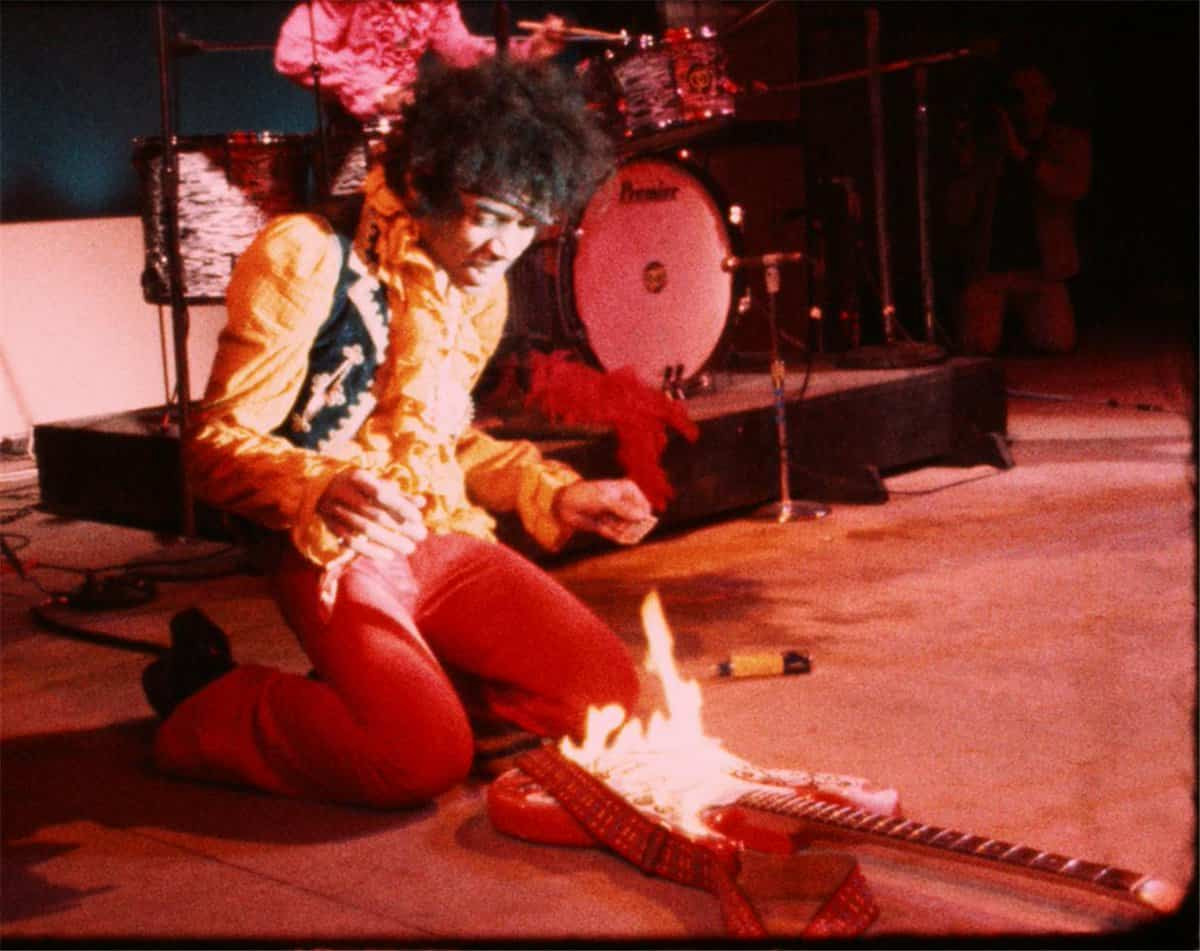 Jimi Hendrix setting his Stratocaster ablaze at the Monterey Pop Festival in 1967, a defining moment in rock history.
Jimi Hendrix setting his Stratocaster ablaze at the Monterey Pop Festival in 1967, a defining moment in rock history.
Fender Stratocasters: The Soulmate Guitars of Jimi Hendrix
Although his musical palette extended beyond a single model, Jimi Hendrix’s name is indelibly linked to the Fender Stratocaster. Once his career skyrocketed, the Stratocaster became his primary instrument, almost exclusively dominating his performances and recordings. Here’s a closer look at some of the most significant and iconic Stratocasters in Jimi Hendrix’s arsenal.
1960 Fender Stratocaster – “Carol”: The Genesis Strat
Likely the first Stratocaster Jimi ever owned, this 1960s model marked the beginning of a lifelong love affair with the instrument. Gifted to him by his girlfriend Carol in New York City, this guitar was a pivotal acquisition just before his transformative move to the UK in 1966. Before his international breakthrough, this stock Stratocaster was simply restrung for his left-handed playing style, becoming a foundational tool in his burgeoning career.
The subsequent history of “Carol” remains shrouded in mystery. It wasn’t the white Strat he carried to the UK, suggesting its use was brief and primarily confined to his pre-fame days in the US. While rumors persist of it being smashed onstage, Jimi’s financial constraints at the time make such an act improbable. “Carol” represents the humble beginnings of Jimi’s Stratocaster journey, a starting point before the legends were forged.
1964 Fender Stratocaster – “Linda”: The White UK Launchpad
A chance encounter with Linda Keith, then-girlfriend of Keith Richards, after a New York City show in 1966 proved to be a turning point. Recognizing Jimi’s raw talent, Linda generously lent him this white 1964 Stratocaster from Keith Richards’ collection. This act of faith provided Jimi with the instrument that would launch his international career.
“Linda” was the sole guitar Jimi took with him when he embarked for the UK in 1966. Throughout that pivotal year, it was his constant companion on stage and in studios across the pond, including crucial TV appearances in December that amplified his visibility. It’s highly probable that the iconic opening chords of “Hey Joe,” the song that catapulted him to fame, were played on this very guitar. Like many of Jimi’s guitars, “Linda” remained stock, a testament to the inherent quality of the era’s Fender instruments. Tragically, this historically significant guitar vanished, stolen in 1967 and never recovered, leaving a void in the story of Jimi Hendrix’s guitars.
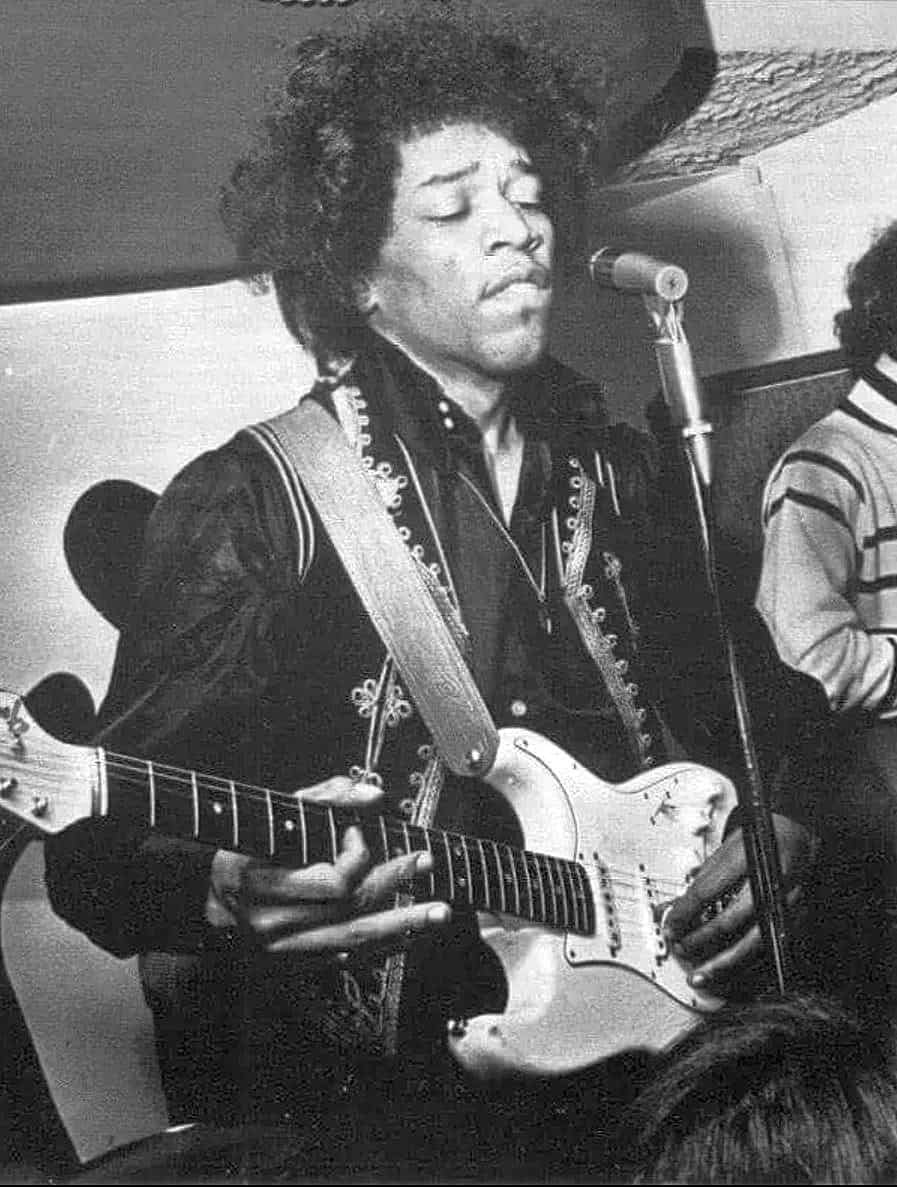 Jimi Hendrix masterfully playing his white Fender Stratocaster, affectionately nicknamed "Linda," during his breakthrough period. Credit: Freddie Mudditt of Fietscher Fotos Ltd
Jimi Hendrix masterfully playing his white Fender Stratocaster, affectionately nicknamed "Linda," during his breakthrough period. Credit: Freddie Mudditt of Fietscher Fotos Ltd
1960s Fender Stratocaster – “Zappa”: The Scorched Enigma
Jimi Hendrix’s burnt 1960s Stratocaster, later owned by Frank Zappa and subsequently his son Dweezil, stands as one of the most enigmatic and iconic guitars in rock history. Its charred appearance tells a story, but the true narrative behind its fiery transformation is a complex puzzle.
Frank Zappa claimed to have acquired this guitar from Jimi’s roadie and assistant, Howard Parker, in 1968. Zappa’s account pointed to the Miami Pop Festival as the site of its ceremonial burning. However, this version of events doesn’t align with eyewitness testimonies and documented evidence. Multiple sources confirm that Jimi did not burn any guitar during his Miami Pop performance, casting doubt on Zappa’s initial story.
The guitar’s distressed state is undeniable, but the Miami Pop narrative is questionable. A more plausible origin points to Hendrix’s infamous Astoria gig in Lancashire, England. Scratches and wear patterns on the back of the “Zappa” Strat body closely match photographic evidence from the Astoria performance, suggesting it may indeed be the guitar ignited on that UK stage. The mystery deepens with questions surrounding Howard Parker’s acquisition of the guitar – he wasn’t working for Hendrix at the time of the Astoria gig. Furthermore, the journey of this scorched instrument from London to the US and into Parker’s possession remains unclear. Why would anyone, let alone Jimi Hendrix, transport a burnt guitar across continents? These unanswered questions solidify the “Zappa” Stratocaster as one of the most intriguing and debated guitars associated with Jimi Hendrix.
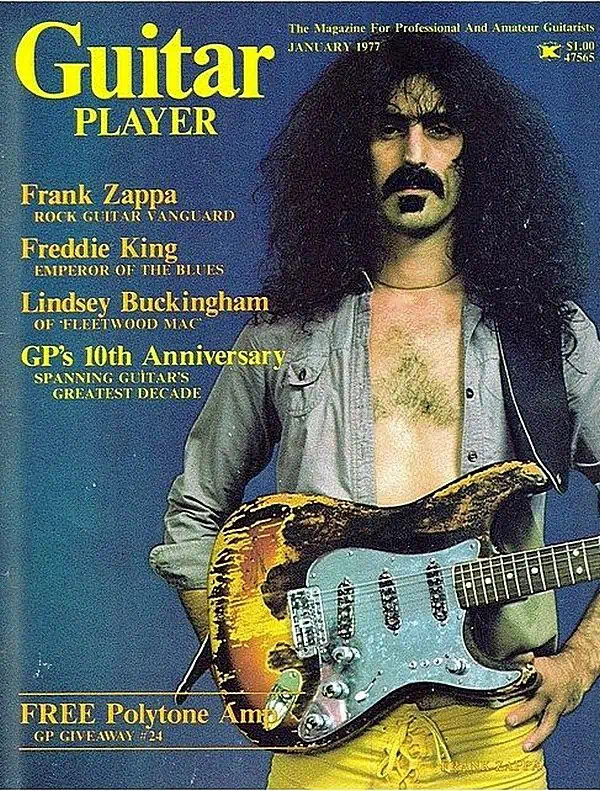 A vintage 1977 issue of Guitar Player Magazine, showcasing Frank Zappa alongside Hendrix's iconic scorched black Stratocaster. Credit: Guitar Player Magazine
A vintage 1977 issue of Guitar Player Magazine, showcasing Frank Zappa alongside Hendrix's iconic scorched black Stratocaster. Credit: Guitar Player Magazine
1963/64 Fender Stratocaster – Monterey Pop: The Ritual Sacrifice
The 1963 or 1964 Stratocaster that Jimi Hendrix immolated at the Monterey Pop Festival is arguably his most globally recognized guitar. Acquired in early 1967, its documented debut was on “Top of the Pops” in March of that year. Originally finished in red with a rosewood fretboard, a departure from his preferred maple necks, this Strat underwent a visual transformation in 1967. Hendrix adorned it with a now-iconic psychedelic paint job, reflecting the era’s vibrant artistic expression.
Despite its colorful, peace-and-love aesthetic, this guitar met a dramatic end at Monterey Pop. Following a blistering performance of “Wild Thing,” Hendrix enacted a ritualistic sacrifice, setting the guitar ablaze and then smashing it to pieces. A fragment of this legendary instrument is now preserved at the Museum of Pop Culture in Seattle, a tangible link to a defining moment in music history. Even though its stage life was brief, the Monterey Strat’s impact is immense. Its visual and symbolic significance has led Fender to release multiple Monterey Strat models, ensuring its legacy continues to inspire generations of guitarists.
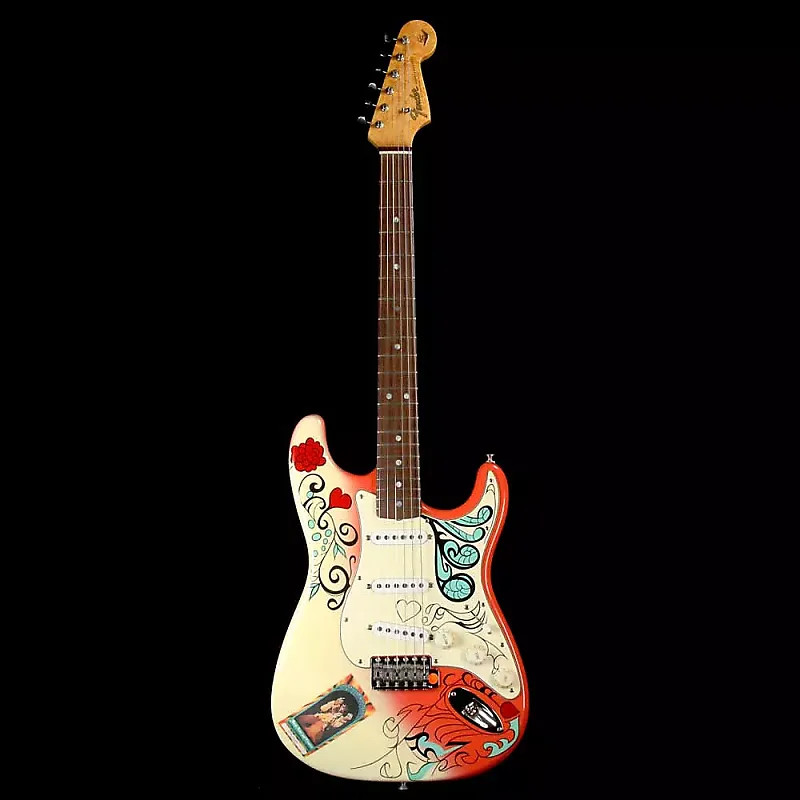 A contemporary Fender Custom Shop Jimi Hendrix Monterey Stratocaster, a tribute to the iconic guitar destroyed at Monterey Pop. Credit: Fender.com
A contemporary Fender Custom Shop Jimi Hendrix Monterey Stratocaster, a tribute to the iconic guitar destroyed at Monterey Pop. Credit: Fender.com
1965/66 Fender Stratocaster – Monterey Black Strat: The Survivor
In contrast to its fiery counterpart, this Black Strat appears to have been a favorite of Hendrix during 1967. It was his primary guitar throughout the Monterey Pop Festival performance and, crucially, survived the show. This resilience allowed it to continue its service, gracing stages at the Fillmore West and the Whiskey a Go-Go later that same year.
However, its lifespan as a whole instrument was finite. While unconfirmed, circumstantial evidence suggests Hendrix burned this Black Strat at the Ambassador Theater in Washington, D.C., marking the last documented instance of him setting a guitar on fire onstage. Following the conflagration, the guitar was smashed, and Hendrix signed the pieces, distributing them to the venue staff as unique souvenirs.
In 2012, a guitar purported to be Hendrix’s black Monterey Strat surfaced for sale, generating considerable buzz. However, its authenticity was quickly called into question. A detailed video analysis by CGS meticulously outlines the inconsistencies and issues undermining its claim, making it highly improbable that the offered guitar was the genuine article. Despite the uncertainty surrounding its fate after the Ambassador Theater incident, the Monterey Black Strat remains a significant instrument in Jimi Hendrix’s story, a workhorse that witnessed some of his most legendary performances.
1960s Fender Stratocaster – The Modified Maverick: Pickup Switching Innovation
This 1960s Stratocaster stands apart as the sole known modified guitar Jimi Hendrix ever played. Observed in his hands only a few times in 1967, its distinctiveness lies in its unconventional pickup switching system.
Instead of the standard five-way switch found on Stratocasters, this guitar featured three independent toggle switches. This modification allowed for individual activation or deactivation of each pickup, unlocking a vast array of pickup combinations beyond the typical Strat configurations. This innovative wiring offered Jimi unprecedented tonal flexibility, potentially contributing to some of his experimental sounds during this period.
However, Hendrix’s limited use of this modified Strat suggests he may not have fully embraced the altered setup. He was never seen with a similar configuration again, and the guitar’s current whereabouts are unknown. Speculation suggests the modified pickguard might have been replaced with a standard Strat wiring harness, allowing Hendrix to revert to a familiar setup. Regardless of its brief appearance in his hands, this modified Stratocaster provides a glimpse into Hendrix’s potential exploration of sonic boundaries and his willingness to experiment with his instruments.
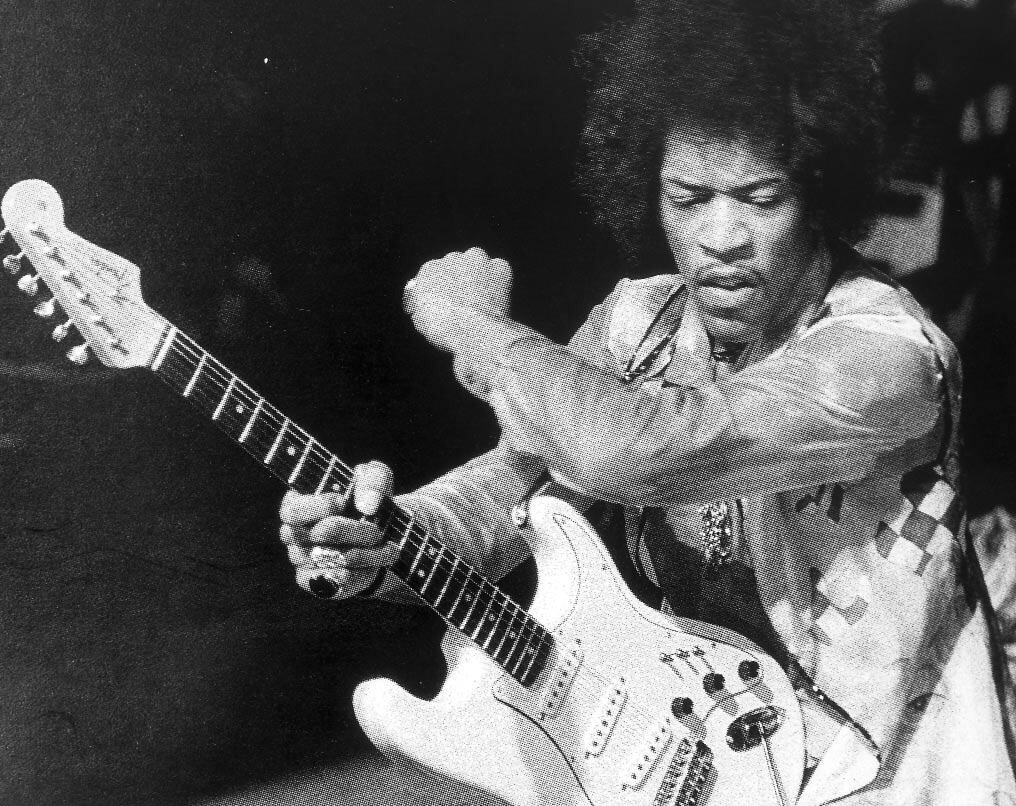 Jimi Hendrix in 1967, playing the uniquely modified Stratocaster with independent pickup switches. Photo source: GitarreBass.de
Jimi Hendrix in 1967, playing the uniquely modified Stratocaster with independent pickup switches. Photo source: GitarreBass.de
1967 Fender Stratocaster – White: The Electric Ladyland Studio Companion
Hendrix favored this 1967 White Stratocaster for a significant portion of 1968, indicating it was a cherished instrument. It accompanied him to major performances, including Miami Pop and the Fillmore East in 1968, among numerous other shows throughout the year.
Beyond its stage presence, this White Strat holds a particularly special place in Hendrix’s discography as a key instrument in the creation of Electric Ladyland. Eddie Kramer, the renowned engineer behind the album, specifically recalls Jimi using a white Stratocaster during the recording sessions for “Voodoo Chile.” It’s highly likely this 1967 White Strat was the very guitar that laid down the iconic blues-rock masterpiece, solidifying its place as a studio legend within Jimi Hendrix’s guitar collection.
1968 Fender Stratocaster – Woodstock: The Star-Spangled Banner Strat
Of all the guitars associated with Jimi Hendrix, this 1968 Stratocaster arguably holds the most iconic status, inextricably linked to his legendary Woodstock performance. Acquired by Jimi in 1968, this guitar remained in its stock configuration and became a regular instrument in his rotation leading up to the monumental Woodstock Festival in 1969.
It was on this very Stratocaster that Hendrix delivered his groundbreaking rendition of “The Star-Spangled Banner,” a performance that transcended music and became a cultural touchstone of the era. The searing, emotionally charged sounds emanating from this instrument at Woodstock are etched into the collective memory of music history.
In 1970, Hendrix gifted this historically significant guitar to Experience drummer Mitch Mitchell. Mitchell retained it until 1991, when it was sold to an Italian TV host and music critic. Its journey continued when it was acquired by Microsoft co-founder Paul Allen. Allen, recognizing its immense cultural value, placed it in his Museum of Pop Culture (MoPOP) in Seattle, where it is now preserved as a priceless artifact of music history, allowing generations to connect with the instrument that voiced one of rock’s most defining moments.
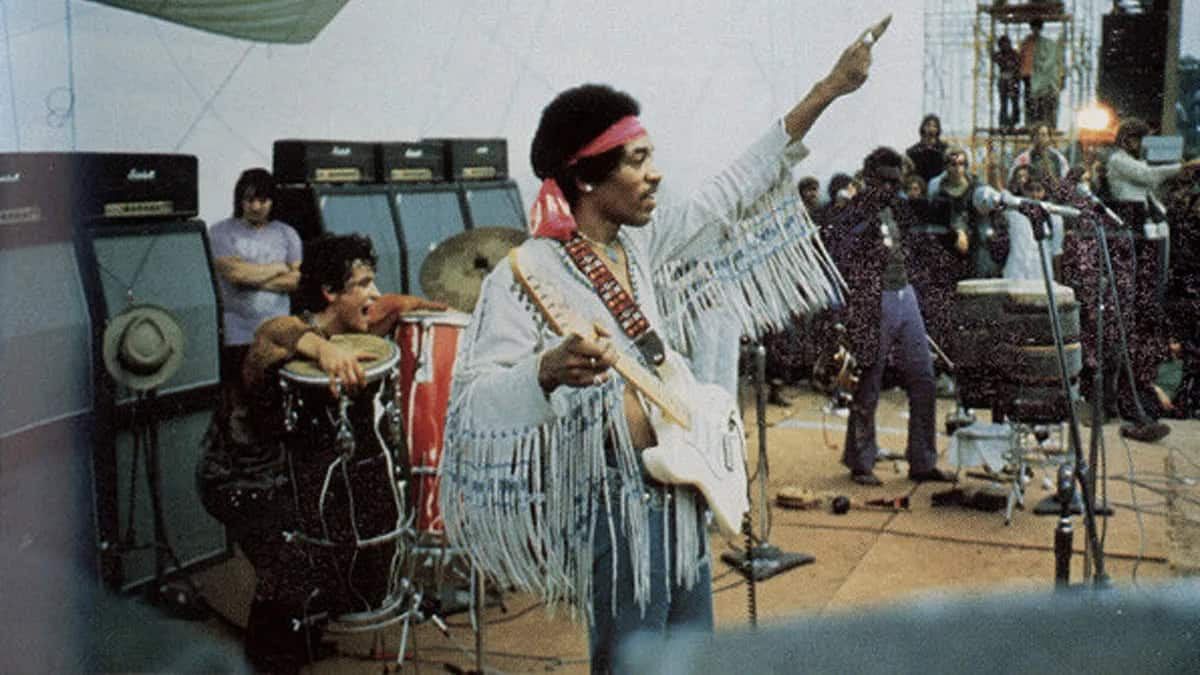 Jimi Hendrix at Woodstock, delivering his generation-defining performance on his 1968 Stratocaster. Source: *Woodstock: The Movie*
Jimi Hendrix at Woodstock, delivering his generation-defining performance on his 1968 Stratocaster. Source: *Woodstock: The Movie*
1960s Fender Stratocaster – Newport Tele-Neck Hybrid: The Unlikely Telecaster Fusion
This Stratocaster stands as a unique anomaly within Jimi Hendrix’s collection, distinguished by one striking feature: a Telecaster neck. Its appearances were limited to just two known shows, one being the Newport Folk Festival, making it a rare and intriguing deviation from his typical Stratocaster preferences.
Neal Moser, a luthier based in Hollywood, claims to have played a role in this guitar’s unusual configuration. According to Moser, he repaired the guitar for Jimi, replacing a broken Stratocaster neck with a Telecaster neck due to a lack of Strat necks on hand at the time. Necessity became invention, resulting in this hybrid instrument that briefly entered Hendrix’s guitar arsenal. The Newport Stratocaster serves as a testament to improvisation and adapting to circumstances, even for a guitar icon like Jimi Hendrix.
Outliers and Oddities: Beyond the Stratocaster Spectrum
While Stratocasters were undeniably central to Jimi Hendrix’s sound, his musical curiosity extended to a wider range of instruments. Any guitar in his hands that wasn’t a Strat could be considered an outlier, offering different tonal colors and playing experiences. Let’s explore some of the notable guitars of Jimi Hendrix that ventured beyond his beloved Stratocaster territory.
1961 Epiphone Wilshire: Nashville Beginnings
Prior to his global fame, Jimi Hendrix spent time in Nashville in 1962, where he co-founded the band The King Casuals with Billy Cox. During this formative period, Jimi’s primary guitar was a 1961 Epiphone Wilshire. Despite his relative obscurity at the time, this Wilshire has become retrospectively associated with his early career and pre-fame sound.
This particular Wilshire likely incorporated modifications, possibly implemented by Jimi himself or a previous owner. The 17th fret inlay was notably larger than the stock version, suggesting it might have been an aftermarket addition, perhaps even a sticker. Furthermore, the guitar featured a tremolo system, which was not a factory option for Wilshires in 1961. These modifications hint at Jimi’s early tinkering with his instruments, seeking to personalize and enhance their performance even in his pre-stardom days.
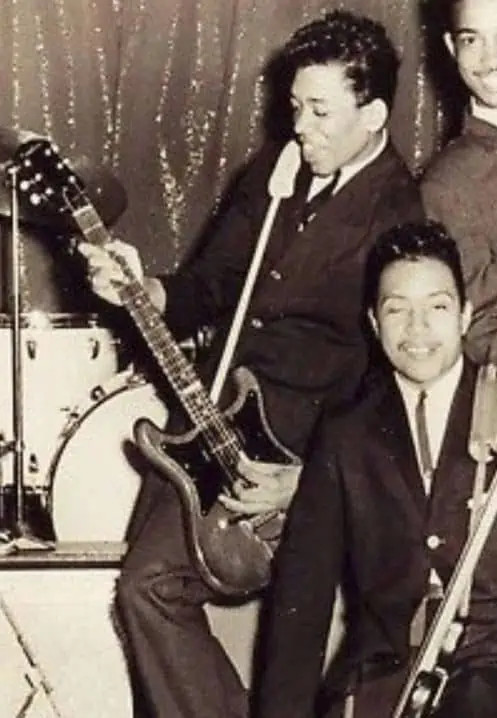 A young Jimi Hendrix, pictured with his 1961 Epiphone Wilshire during his early career.
A young Jimi Hendrix, pictured with his 1961 Epiphone Wilshire during his early career.
1967 Hand-Painted Gibson Flying V: A Psychedelic Statement
Jimi Hendrix’s use of this 1967 hand-painted Gibson Flying V was brief, yet it remains an enduringly iconic guitar, primarily due to its visually striking custom paint job. Acquired in the summer of 1967, it became one of his main stage guitars until early 1968, making a bold visual statement alongside his increasingly flamboyant stage presence. Beyond its artistic embellishments, it was a stock Flying V, offering a different tonal and playing experience compared to his Stratocasters.
Rumors have circulated regarding the Flying V’s presence on Electric Ladyland, specifically on the track “All Along the Watchtower.” However, these claims remain unsubstantiated. Regardless of its potential studio contributions, the hand-painted Flying V was undoubtedly a prominent stage guitar for Hendrix during a pivotal period of his career, its vibrant artwork mirroring the psychedelic sounds he was pioneering.
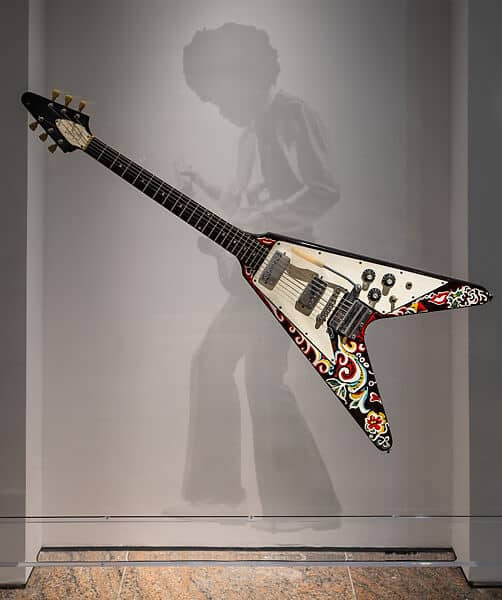 Jimi Hendrix's hand-painted Gibson Flying V, displayed at the Metropolitan Museum of Art, showcasing its iconic psychedelic artwork. Credit: Metropolitan Museum of Art.
Jimi Hendrix's hand-painted Gibson Flying V, displayed at the Metropolitan Museum of Art, showcasing its iconic psychedelic artwork. Credit: Metropolitan Museum of Art.
Mosrite Joe Maphis 12/6 Doubleneck: Spanish Castle Magic’s Secret Weapon
This unusual Mosrite Joe Maphis 12/6 doubleneck guitar holds a unique place in Jimi Hendrix’s discography as the instrument used to record “Spanish Castle Magic” from Bold as Love. Its distinctive sound and visual presence set it apart from his more commonly used guitars.
Conflicting accounts surround Jimi’s acquisition of this doubleneck Mosrite. Some sources suggest he purchased it from a music shop in New York City. In contrast, Dana Moseley, daughter of Mosrite founder Semie Moseley, recalls Jimi personally visiting the factory to pick up the guitar. Regardless of the exact circumstances of its acquisition, the Mosrite doubleneck became a crucial tool in crafting the unique sonic landscape of “Spanish Castle Magic,” adding a textural richness and complexity to the track. While not as visually iconic as some of his other guitars, the Mosrite doubleneck played a significant role in shaping a key song in the Jimi Hendrix catalog.
1965 Fender Sunburst Jazzmaster: The Steven Seagal Connection
This 1965 Jazzmaster is a rare sighting in Jimi Hendrix’s guitar history. While photographic evidence places it at the Miami Pop Festival, there’s little documentation of Jimi himself actively playing it. However, this guitar’s claim to fame lies in its subsequent ownership: it was eventually purchased by Steven Seagal.
Yes, that Steven Seagal, the action movie star with a lesser-known passion for blues guitar and guitar collecting. For those unfamiliar with Seagal’s musical pursuits, a humorous and insightful video by former Reverb writer Casey Hopkins delves into this unexpected facet of his career. Hopkins’ investigation revealed that Seagal divested himself of many guitars before relocating to Russia. The current whereabouts of this particular Jazzmaster remain unknown, adding another layer of intrigue to its already unusual story.
1956 Gibson Les Paul Custom: Fillmore West & Miami Pop Gibson Debut
While fundamentally a Fender devotee, Jimi Hendrix did occasionally embrace Gibson guitars. This 1956 Les Paul Custom entered his collection in early 1968 and became a notable, albeit infrequent, part of his stage and potentially studio arsenal.
Hendrix regularly played his Les Paul Custom during spring 1968 performances of “Red House,” showcasing its bluesier tonal character. More famously, he wielded it at both the Fillmore East in 1968 and Miami Pop a week later, marking significant performances where a Gibson took center stage. Despite these high-profile appearances, Hendrix didn’t extensively use this Les Paul Custom. However, its presence at two of his most celebrated performances cements its status as a noteworthy Gibson within the guitars of Jimi Hendrix.
1967 Gibson SG Custom: A Nod to Clapton, A Stage Staple
Jimi Hendrix acquired this white 1967 SG Custom in 1968, and it saw considerable use throughout the remainder of his career. He frequently incorporated it into performances of “Sunshine of Your Love,” a deliberate homage to Eric Clapton’s signature SG sound with Cream. Most famously, Hendrix played this SG during his memorable appearance on the Dick Cavett show in 1969, further solidifying its place in his visual and sonic legacy.
Speculation suggests Jimi may have favored the SG Custom due to its inherent left-handed playability. SGs possess a near-symmetrical body shape, eliminating many of the ergonomic challenges faced when playing right-handed guitars upside down. Hendrix’s SG Custom is now preserved for public viewing at the Hard Rock Cafe in Atlantic City, New Jersey, allowing fans to witness a guitar that contributed to his stage presence and sonic versatility.
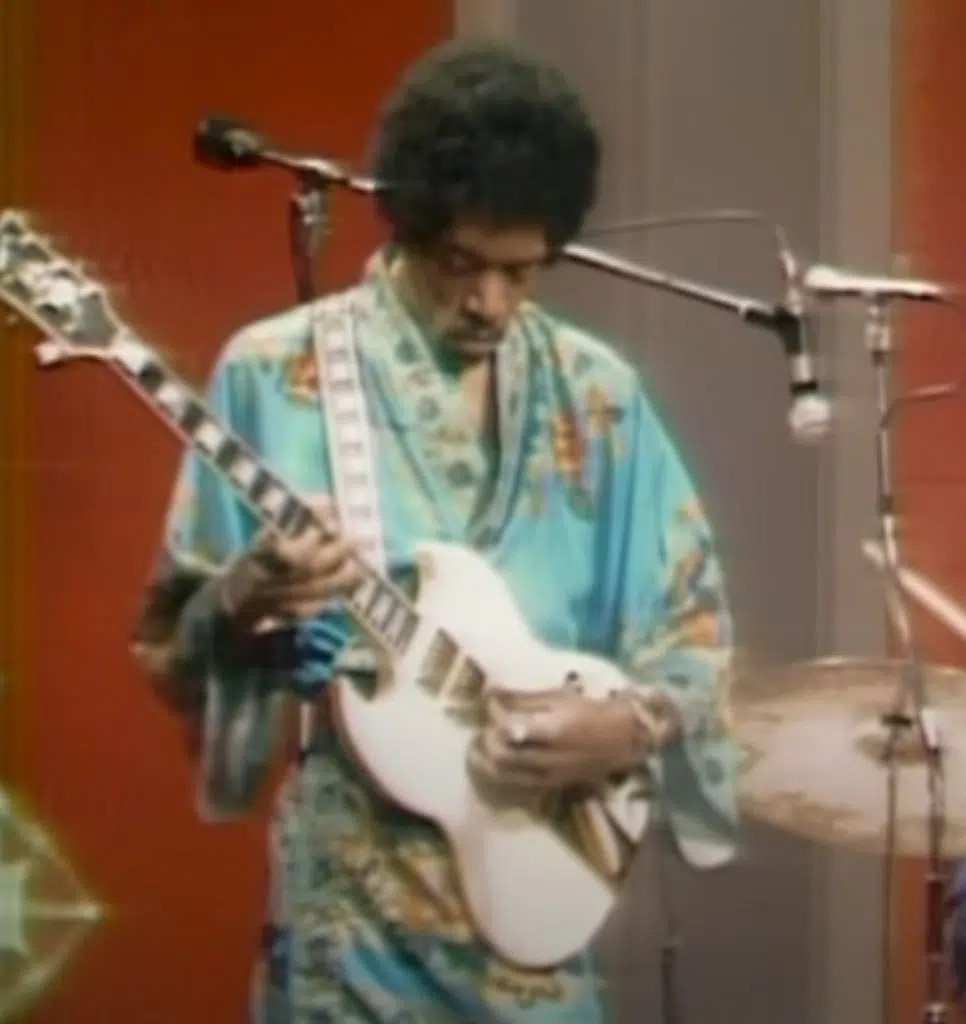 Jimi Hendrix playing his white Gibson SG Custom during his performance on the Dick Cavett show in 1969.
Jimi Hendrix playing his white Gibson SG Custom during his performance on the Dick Cavett show in 1969.
1970 Gibson Left-Handed Flying V: The Isle of Wight Finale
This 1970 Flying V holds the distinction of being custom-made for Jimi Hendrix in the spring of 1970. He played it until his untimely passing, with its most prominent appearance at the Isle of Wight Festival in August 1970, just weeks before his death. This final Flying V represents the culmination of his guitar journey.
While largely based on a standard Flying V design, this custom instrument incorporated unique features tailored to Jimi’s preferences. It featured split diamond inlays, a fully bound neck, a Les Paul Custom truss rod cover, and an inlaid Gibson logo on the headstock. These personalized touches elevated it beyond a standard model, making it uniquely his. Hendrix’s 1970 Left-Handed Flying V is now on display at the Hard Rock Cafe in London, England, serving as a poignant reminder of his final performances and enduring musical impact.
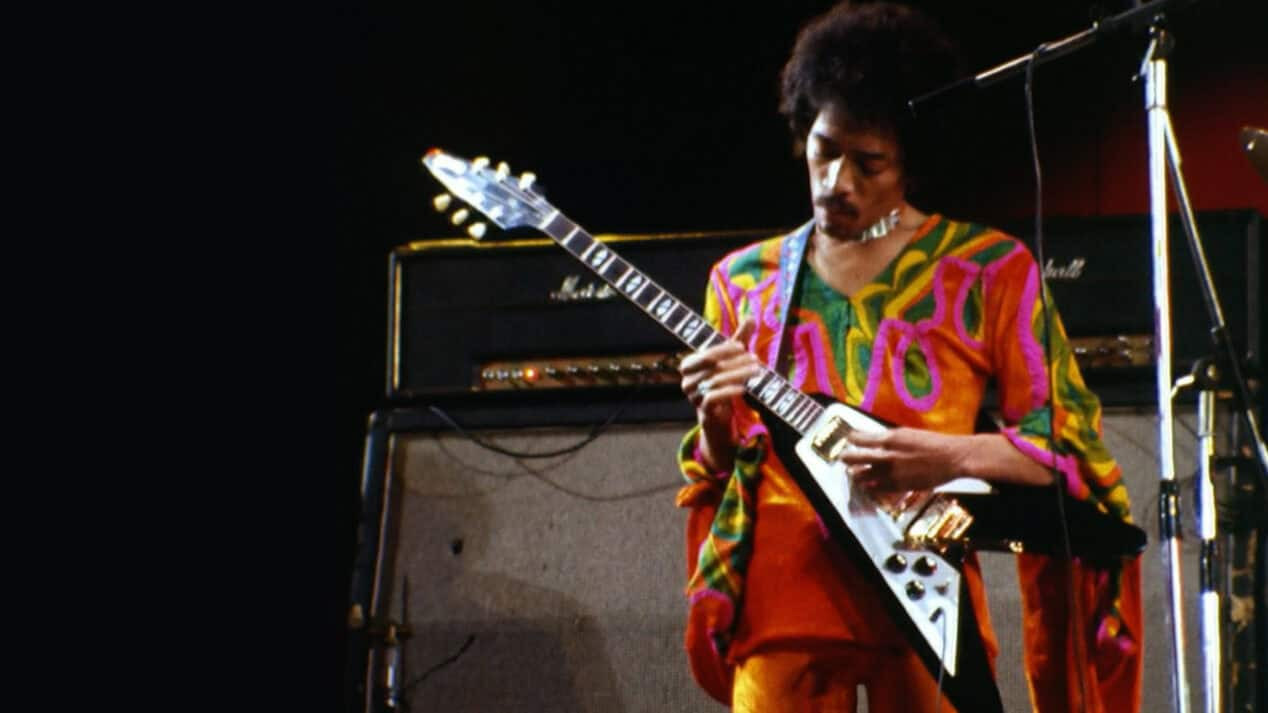 Hendrix performing with his custom-made left-handed Flying V at the Isle of Wight Festival in 1970, one of his last major performances. Credit: Chris Walter
Hendrix performing with his custom-made left-handed Flying V at the Isle of Wight Festival in 1970, one of his last major performances. Credit: Chris Walter
Hendrix’s Legend = Legendary Guitars: An Enduring Fascination
In his tragically short but immensely impactful career, Jimi Hendrix transcended the role of guitarist to become the vanguard of rock guitar and an undisputed icon for musicians across genres. The profound influence of his otherworldly playing continues to resonate, ensuring that his choice of instruments remains a source of endless fascination for players and enthusiasts alike. While this fascination often inspires aspiring guitarists to pick up a Stratocaster, this exploration reveals that Jimi, like many dedicated players, was a true guitar aficionado, constantly seeking new sonic textures and experiences through diverse instruments. So, whether you’re fortunate enough to own one of the guitar models associated with Jimi Hendrix or simply admire his legacy, take inspiration, grab your own guitar, wind it up with Stringjoys, and let that Hendrix-inspired chord ring out! (And perhaps, as a safety precaution, keep any open flames a safe distance from your instrument).

